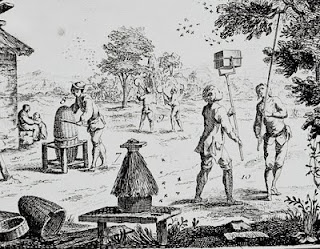So far in this series we have taken a journey from the origins of bees, through ancient civilisations, and explored the relevance of bees in religion. In this final article of the series we will explore bees in the modern world from the 17th century onwards.
17 and 18th century
With the help of human migration bees spread across the world. Honey bees were brought to America by English colonists in the early 17th century.
 |
Beekeeping in 1772 as illustrated in L’Encyclopédie ou Dictionaire Raisonné Des Sciences et Arts et des Métiers (a major French encylopaedia of the 18th century |
19th century
Beekeeping became a commercially viable activity aided by the several important inventions including: frame hives, the smoker, comb foundation, and honey extractor.
 |
Lorenzo Langstroth (1810-1895) |
Lorenzo Lorraine Langstroth invented the moveable comb hives. He was the first person to make use of an earlier discovery by Huber of the bee space – the specific distance between wax combs at which bees did not fill in but rather kept the space open as free passage. Using this principle, Langstroth designed wooden frames to fit within a rectangular box with the correct bee space between successive frames. This allowed frames to be removed and inspected without harming the bees. It also meant that honey could be extracted without destroying the comb.
 |
Early design of a honey extractor |
The honey extractor was invented in 1865 by a Czech beekeeper and designer called Francois Hruschka. Before this, honey was extracted by pressing the honeycombs. All the extractors have a basic structure consisting of an outer tank, an inner drum in which the honeycomb is placed, and a drive element. As the rotor turns, honey is sprayed against the walls of the drum due to centrifugal forces and is released for collection via a tap.
Even in ancient times, as we have seen in this series, it was well known that smoke calmed bees. The underlying mechanism is still not known but it is thought that the smoke masks alarm pheromones released by bees. The problem of delivering a long, steady stream of smoke to calm bees during inspections was finally overcome in 1870 with the invention of the Moses Quinby smoker. Moses Quinby was reportedly the first commercial beekeeper in the United States.
20th and 21st century
Global warming is a major phenomenon of our times having widespread effects on our ecosystem. Although bees are resilient and able to adapt to changes in temperature, subtle changes may have unexpected effects such as the accelerated growth of pathogens which could harm bees. With the rise of industrialisation in the less econonomically developed world and the lack of consensus on how to tackle this at the G8 summit this may become a major problem in the decades ahead.
Even now, colony collapse disorder, the phenomenon where worker bees from a hive suddenly disappear without trace has become a major and worrying problem in North America. Similar disappearances have also occurred in a number of European countries. It is still not clear what the underlying cause of colony collapse disorder is but a number of factors may be responsible. There is growing evidence that the rising use of neonicotinoids in pesticides could be an important factor.
These examples serve as a reminder that we need to work with nature in order to sustain the benefits nature provides for mankind. Unless we do this, we risk denying future generations the benefits of nature we enjoy today.
This series about Bees Throughout the Ages has highlighted just how important bees as well as their keepers have been throughout history. I hope you have enjoyed the series and I hope it has provided inspiration for us all to continue supporting bees for future generations to enjoy!


Thanks for the series, I’ve enjoyed it. Will you take the BBKA’s Module 8 exam on beekeeping history – or perhaps you’ve done it already?
Thanks, it’s nice to hear you enjoyed it. The module sounds like a great idea – I’ll look into it!